Christian joy is truly expressed not primarily in ecstasy but in tranquillitas, in domestic harmony… an habitual state rather than an occasional vivid experience of sensible devotion. – Martin Thornton
Wright remained a religious man, but that did not make him a charitable one. His growing belief that he had been bypassed and even cheated… combined with his feeling of homage due but not delivered, fed resentments that were to reach near paranoid proportions. –Ada Louise Huxtable
Spring Green, WI. I stepped onto the grounds of Taliesin like an atheist reluctantly attending a nephew’s baptism. I wanted to believe – really, I did – and I vowed to myself I would be polite. But I knew how the story ended, and so all the charming Frank Lloyd Wright quotes (“I had to choose between honest arrogance and hypocritical humility;” “Take care of the luxuries and the necessities will take care of themselves,”) bounced off my unimpressed countenance like rain off one of the Wright-themed umbrellas for sale in the gift shop.
But perhaps something would surprise me; that’s why I was there; and if Taliesin had a shot at winning me over, this was the day. The drive through the topographically variegated Driftless Region of Wisconsin, missed by the glaciers that otherwise flattened the Midwest, was rapturous. Tour companies name days like this “peak fall” and jack up their rates. Taliesin means “shining brow” in Welsh, and the hill that it faced was aglow in the same yellow as the fabric of the cushions Wright had carefully selected for his living room. Surely this was no accidental harmonization. Still, despite the way the building elegantly enmeshed itself in the elevation, despite the intelligently asymmetrical doorknobs ruminated upon by our kind and learned tour guide, despite the flash of autumn color through perfectly cut diamond-shaped windows, despite the unbroken architectural lines fixated upon at length, the house kept whispering a different message back.
The crime is no secret, though the motive still may be. Wright had built the getaway following his affair with the wife of a client, a woman named Martha (Mamah) Borthwick Cheney. Rejected by Oak Park society, the couple absconded north to Spring Green, Wisconsin near where Wright was born. The land was purchased by Wright’s mother, enabling her son to construct a “love castle” (as critics called it) in harmony with the hillside. “Laws and rules are made for the average” (125), Wright insisted, anticipating the character in Woody Allen’s 1994 film Bullets Over Broadway who boasts, “the artist creates his own moral universe.”
Taliesin was also a fully functioning farm, and Wright needed workers to keep it functioning. He hired Julian and Gertrude Carlton, persons of color, about whom not much more was known. They appear to have been part of the Great Migration of African Americans from the south seeking work (199). They claimed to be from Barbados to facilitate gaining employment, perhaps to win for themselves “sad but mitigating cachet” (88) to counter the era’s endemic racism. They were the only black people at Taliesin, and possibly for miles around. It appears that one of Wright’s draftsman, Emil Brodelle, referred to Carlton with a racial slur when Carlton refused to saddle his horse, even though Carlton was a cook and not a farm hand (192). But awful as this may be, it still does not explain what Julian Carlton then brought to pass.
While Wright was redesigning a beer garden in Chicago, Carlton murdered Wright’s lover and her two visiting children, John (age 12) and Martha (age 8) as they consumed the soup he had just served them. The weapons were a shingling hatchet, gasoline and a match. Carlton dispatched servants who escaped the blazing home with the axe as well, including the draftsman Emil Brodelle. The dead included a carpenter and his 13-year-old son as well as a gardener in his sixties.
Simple revenge cannot account for a tragedy of this scale, which remains as inexplicable as evil itself. “The lightning struck us – why, no one can say,” wrote Frank Lloyd Wright of the incident (199). Much more recently, Paul Hendrickson, after traveling the country to find everything he could about Julian Carlton, puts it this way in his 2019 book Plagued by Fire:
There had to have been ten thousand things burning in Julian Carlton’s chaotic mind when he did what he did that noonday. Let that event, that moment, stand unopposed in its meanings and mysteries (191)….
The swirling ghosts of a Deep South past are at least a part of the answer. Let it be. All theories are suspect….” (308).
Perhaps the most insightful commentary on the event comes from the black Chicago artist Kerry James Marshall ruminated upon the killing in a 2009 painting, where he depicts Carlton under the name of a fictional actor, “Hezekiah Washington,” I expect to give us (and the artist) some necessary distance. Carlton’s head seems about to sprout horns, his fists almost appear chained, but are also clenched as he stews in his own rage, or perhaps in the acid that he consumed after he completed the murders. (Carlton never revealed his motives, and died weeks later from the poison he imbibed.) Marshall’s painting mixes murder and beauty; the celebratory designs of Wright that loom in the background are laughably meaningless when juxtaposed with Carlton’s menacing frame. That painting is what it feels like to tour Taliesin, even on a splendid October day.
“In action there is release from anguish,” wrote Wright after the murders; “work only was bearable” (140). He rebuilt Taliesin with a fury to “put the soul of her [his mistress] into the forms that take shape under my hands” (196). Still, the home’s beauty, for me at least, was not resilient enough to erase the stain. As the bus drove back down the hill to the visitor’s center, I thought to myself that it was among the saddest homes in America. After the tour, I made my way to the Unitarian chapel that Wright had modified as a young boy, and where his ancestors, his murdered mistress and he (before his third wife absconded with his remains to Taliesin West) were buried. There were plenty of decorative Buddhas in Taliesin, but no crosses; nor were there any crosses that I could find among these graves, and what other than a cross could help heal this deepest of Wisconsin wounds? In short, my unbelief in Taliesin was confirmed.
Although I imagined such a conclusion would be unavoidable, I risked the trip because I had an escape hatch: The House on the Rock, a home near Taliesin built on a cliff face by a local eccentric named Alex Jordon Jr. (d. 1989) almost in defiance of the celebrity surrounding Frank Lloyd Wright. The House on the Rock is, to get right to the point, the Jerusalem of Weird. I should explain at the outset that I have a weakness for things dismissed as American kitsch. I love to see such sites vindicated. Once I visited the Precious Moments Chapel outside of Carthage, Missouri on a dare. I was completely won over, and I have been back three times. I was hoping something similar would happen at House on the Rock. I anticipated a Chris Arnade-style vindication of Americana to offset the snobbery, and the tragedy, of the cult of Wright. As beautiful as Taliesen may be, as a home—as a place that imparted love and security—it had failed. By comparison, the House on the Rock, I predicted, would stand firmly, in my mind at least, as “the winds and rains came down” (Matthew 7:25).
And for the first hour at least, my expected interpretation of the site was confirmed. Everything that Wright loved and admired – Japanese culture, stained-glass, fireplaces sculpted from local Wisconsin stone –was here turned up to eleven, and all of it was deliberately awful. The tasteful American bourgeoisie – those who drop hundreds at the Taliesin gift shop – had no editing powers here. Everything was permitted. Wright’s jibe that interior decoration is frequently “inferior desecration” is happily owned and exuberantly amplified at House on the Rock. The insult becomes a vocation. The stories I had just heard of Wright playing the piano at Taliesin for his acolytes morphed at House on the Rock into Vaudeville-style player pianos on repeat. There were even references to the Lamb of God in retrofitted stained glass windows, as if Alex Jordan Jr. was thumbing his nose at Wright’s reticence to incorporate Christian subject matter into his designs.
When I exited the domestic portion of House on the Rock and entered the extravagant museum portion of the facility, my hot take reached the boiling point. A massive three-story fake whale, in combat with a squid, towered in the center of a maritime display. Below the whale is a man in a boat, completely dwarfed by the creature, to say nothing of the wave that is about to overwhelm him. The man in the ship, I immediately realized, was Frank Lloyd Wright: his famously outsized ego capsized by forces beyond his or anyone’s control.
Had the House on the Rock stopped there I would be prepared to declare it the greatest starchitecture sendup in the United States. For all of Wright’s greatness, even the tragedy at Taliesin seemed unable to bring his overweening confidence into check. This was a service offered instead by the House on the Rock. Quips like “Frank Lloyd Wrong” or “Wright-mare” were not enough. Only this massive accumulation of curiosities, collectibles, and bric-a-brac – easily exceeding the most ambitious “found art” assemblages in any prestigious Manhattan or Los Angeles gallery exhibition – contained the firepower necessary to vanquish the vanity of Wright, to trigger at last the mercy that Wright (and all of us) require.
At least that is what I would have concluded, had House on the Rock stopped at the whale room. But it kept going, for more rooms than my psyche is able to summon without doing further damage to itself. Somewhere in the merry-go-round room, or maybe the organ room or one of the doll, clown or circus rooms, or perhaps it was next to the mannequin orchestra or along the “lanes of yesterday” leading to the “tribute to nostalgia,” the House on the Rock went from compelling to creepy. The Jerusalem of Weird became the Babylon of Bizarre. It became a Rube Goldberg machine of a Rube Goldberg machine, the hideous love child of Branson and Wisconsin Dells, but absent any of the friendliness, and more than a little bit mean. It is not that the attendants were unfriendly – they were as Wisconsin-kind as anyone can be. The cruelty was in the sight of things I can’t unsee.
House on the Rock concludes with a carousel of salacious centaurs (nude female mannequins with the heads of unicorns and bulls). My last impression was of a Satan figure lifting up a weapon to crush a naked mannequin with what seemed like an axe. I left feeling as gutted as I did at Taliesin, with only enough energy to notice in the gift shop that Alex Jordan Jr.’s biography is entitled Never Enough. Between these two homes, I then realized, I had seen the worst of America: the brittle surface of “good design” shattered by an underlying magma of rage, and the reverse snobbery of the rest of America, where kitsch soon curdles into the gratuitously obscene.
Still, I wasn’t about to permit myself a trip like this, with the visual and emotional assault that comes with it, without some kind of further insurance. As I crossed the border from Wisconsin back to my home State of Illinois, I had plans to visit a monastery. A non-descript white cross marked the entrance, and as I pulled into the grounds itself, a pathway of green tress frosted with orange welcomed me onward. The monastery is part of a string of foundations connected to the legendary Father Ephraim (1927-2019), a monk from Mount Athos I once had the privilege of seeing. He died recently, but the global network of monasteries and convents he founded endures. The ones in Greece I had visited are as perfectly ensconced in the rocks as is Wright’s Taliesin or Falling Water; but this particular monastery in Illinois had no such architectural ambitions.
As I pulled up to the main building, it appeared on first sight to be just another American country home overlooking a patch of Illinois farm. I expect the family that built it was constructing not their own Taliesin, or their House on the Rock – but something modestly in between. In any event, it had now become a site of contemplation instead, as every American home can be.
The basement was retrofitted to become a sanctuary, with machine-replicated (and thereby more affordable) icons enhancing the space. It was Mount Athos on a budget, and it worked. The famous icons that I recognized from the Holy Mountain – the Portaitissa from Iviron, the Glykophilousa from Philotheou – were radiantly present. As I entered, a black-robed monk was prostrate before a large icon of the Virgin and Christ, and instead of introducing myself as I might have a decade ago, I made sure not to bother him. As he slipped away upstairs, I sat in silence. I noticed how the icon of the Virgin of the Passion, where a frightened Jesus’s sandal is falling off as he is held by his mother, matched a large icon of the Transfiguration where a disciple’s sandal is falling off as well. Jesus was atop his own golden-hued “shining brow,” and the force of the celestial vision was powerful enough, it seems, to dislodge footwear, and to cleanse what I had seen that October weekend as well.
Gazing at the icon of Mary, I imagined the boy and girl murdered at Taliesin in her arms. I imagined Mary holding Mamah Berthwick, Emil Brodelle and Julian Carlton when they were still just babies, before the careening trajectories of their lives unfurled. I imagined Mary holding the ambitious boy who loved his blocks, and who once just hoped to expand and beautify a Unitarian church. Looking at the icon of the Transfiguration, I swapped out Frank Lloyd Wright, Julian Carlton, and Alex Jordan Jr. for the three disciples, each of them knocked to the ground. Whether they felt the beams of love emanating from the man on the hillside as wrath I do not know; and it is not my business.
My only business was to further flee from the Driftless Region’s precarious highlands. My destination was a one-story house on the flat suburbanized prairie, teeming with affordable icons, with no elevation in sight.


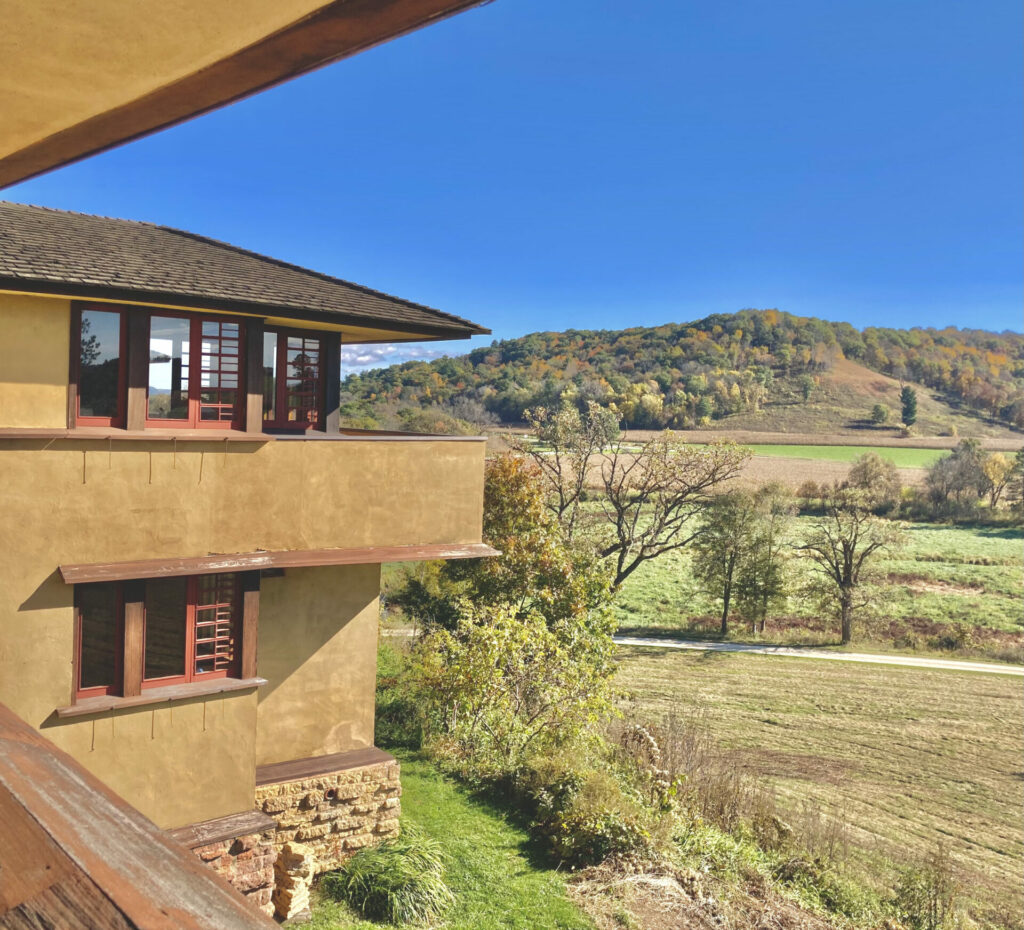
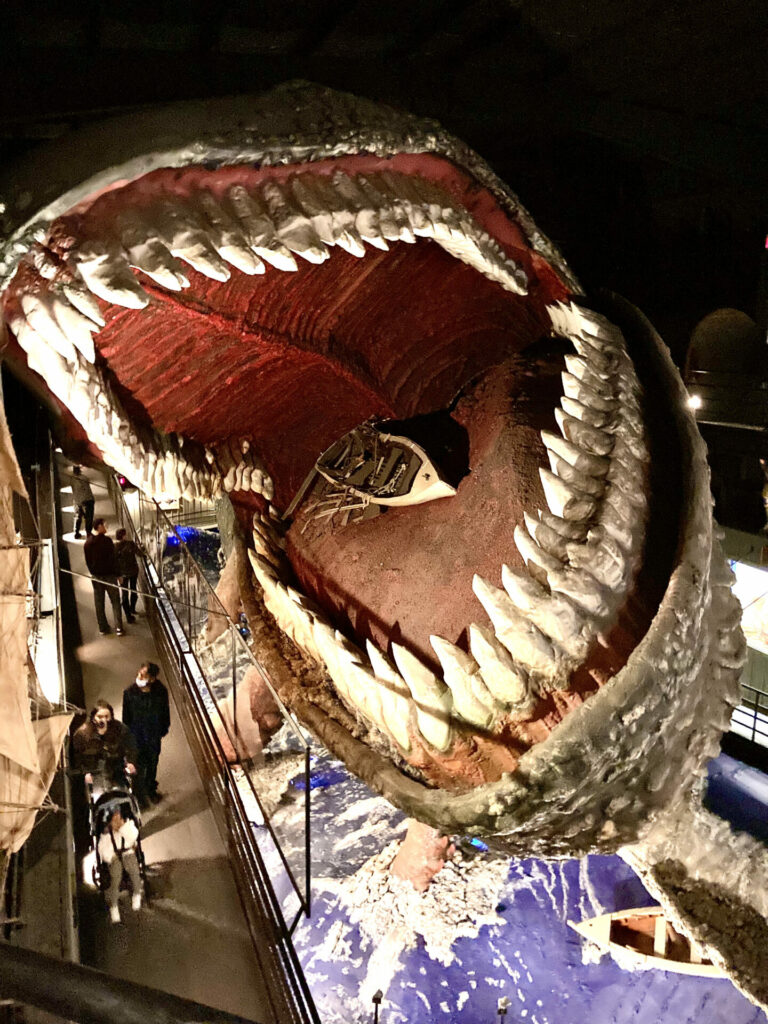
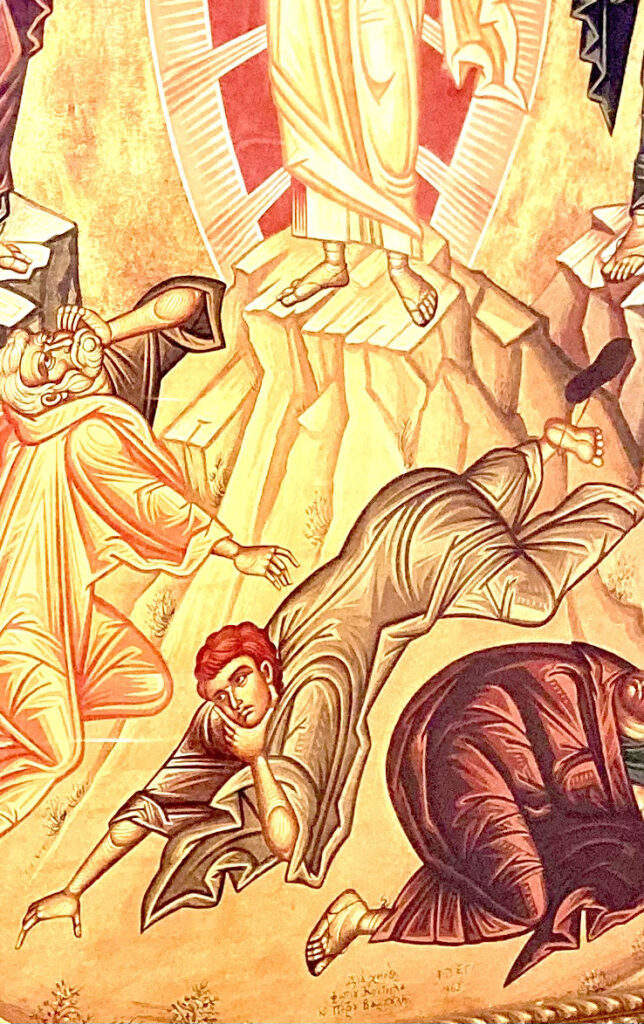

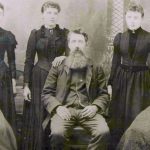

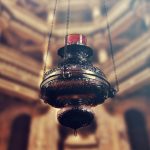
2 comments
Chris Upham
Quick nitpick about a typo: the black-robed monk was ‘prostrate’, not ‘prostate’. As a scholar of medieval philosophy, I can tell you that the latter image brought to mind illuminated manuscript cartoons of trumpets being played from the backside. But I take it this was a monk in a less jocular position.
Thanks for the reflections, though.
Jeffrey Bilbro
Thanks for catching that!
Comments are closed.